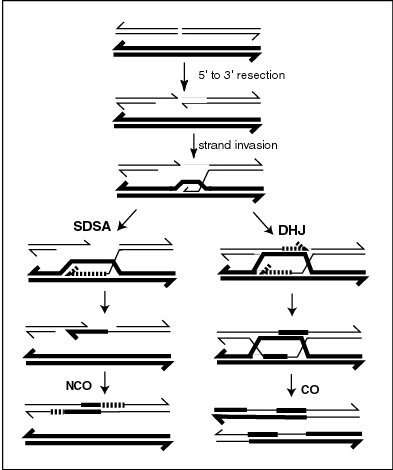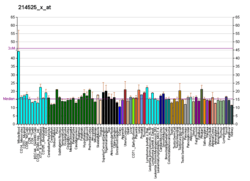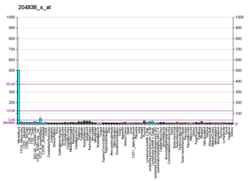MLH3
DNA mismatch repair protein Mlh3 is a protein that in humans is encoded by the MLH3 gene.[5][6]
Function
This gene is a member of the MutL-homolog (MLH) family of DNA mismatch repair (MMR) genes. MLH genes are implicated in maintaining genomic integrity during DNA replication and after meiotic recombination. The protein encoded by this gene functions as a heterodimer with other family members. Somatic mutations in this gene frequently occur in tumors exhibiting microsatellite instability, and germline mutations have been linked to hereditary nonpolyposis colorectal cancer type 7 (HNPCC7). Several alternatively spliced transcript variants have been identified, but the full-length nature of only two transcript variants has been determined.[6] Orthologs of human MLH3 have also been studied in other organisms including mouse and the budding yeast Saccharomyces cerevisiae.
Meiosis
In addition to its role in DNA mismatch repair, MLH3 protein is also involved in meiotic crossing over.[7] MLH3 forms a heterodimer with MLH1 that appears to be necessary for mouse oocytes to progress through metaphase II of meiosis.[8]

The MLH1-MLH3 heterodimers promote crossovers.[7] Recombination during meiosis is often initiated by a DNA double-strand break (DSB) as illustrated in the accompanying diagram. During recombination, sections of DNA at the 5' ends of the break are cut away in a process called resection. In the strand invasion step that follows, an overhanging 3' end of the broken DNA molecule then "invades" the DNA of a homologous chromosome that is not broken forming a displacement loop (D-loop). After strand invasion, the further sequence of events may follow either of two main pathways leading to a crossover (CO) or a non-crossover (NCO) recombinant (see Genetic recombination. The pathway leading to a CO involves a double Holliday junction (DHJ) intermediate. Holliday junctions need to be resolved for CO recombination to be completed.
In the budding yeast Saccharomyces cerevisiae, as in the mouse, MLH3 forms a heterodimer with MLH1. Meiotic CO requires resolution of Holliday junctions through actions of the MLH1-MLH3 heterodimer. The MLH1-MLH3 heterodimer is an endonuclease that makes single-strand breaks in supercoiled double-stranded DNA.[9][10] MLH1-MLH3 binds specifically to Holliday junctions and may act as part of a larger complex to process Holliday junctions during meiosis.[9] MLH1-MLH3 heterodimer (MutL gamma) together with Exo1 and Sgs1 (ortholog of Bloom syndrome helicase) define a joint molecule resolution pathway that produces the majority of crossovers in budding yeast and, by inference, in mammals.[11]
Interactions
MLH3 has been shown to interact with MSH4.[12]
References
- GRCh38: Ensembl release 89: ENSG00000119684 - Ensembl, May 2017
- GRCm38: Ensembl release 89: ENSMUSG00000021245 - Ensembl, May 2017
- "Human PubMed Reference:". National Center for Biotechnology Information, U.S. National Library of Medicine.
- "Mouse PubMed Reference:". National Center for Biotechnology Information, U.S. National Library of Medicine.
- Lipkin SM, Wang V, Jacoby R, Banerjee-Basu S, Baxevanis AD, Lynch HT, Elliott RM, Collins FS (Jan 2000). "MLH3: a DNA mismatch repair gene associated with mammalian microsatellite instability". Nature Genetics. 24 (1): 27–35. doi:10.1038/71643. PMID 10615123.
- "Entrez Gene: MLH3 mutL homolog 3 (E. coli)".
- Sonntag Brown M, Lim E, Chen C, Nishant KT, Alani E (2013). "Genetic analysis of mlh3 mutations reveals interactions between crossover promoting factors during meiosis in baker's yeast". G3: Genes, Genomes, Genetics. 3 (1): 9–22. doi:10.1534/g3.112.004622. PMC 3538346. PMID 23316435.
- Kan R, Sun X, Kolas NK, Avdievich E, Kneitz B, Edelmann W, Cohen PE (2008). "Comparative analysis of meiotic progression in female mice bearing mutations in genes of the DNA mismatch repair pathway". Biol. Reprod. 78 (3): 462–71. doi:10.1095/biolreprod.107.065771. PMID 18057311.
- Ranjha L, Anand R, Cejka P (2014). "The Saccharomyces cerevisiae Mlh1-Mlh3 heterodimer is an endonuclease that preferentially binds to Holliday junctions". J. Biol. Chem. 289 (9): 5674–86. doi:10.1074/jbc.M113.533810. PMC 3937642. PMID 24443562.
- Rogacheva MV, Manhart CM, Chen C, Guarne A, Surtees J, Alani E (2014). "Mlh1-Mlh3, a meiotic crossover and DNA mismatch repair factor, is a Msh2-Msh3-stimulated endonuclease". J. Biol. Chem. 289 (9): 5664–73. doi:10.1074/jbc.M113.534644. PMC 3937641. PMID 24403070.
- Zakharyevich K, Tang S, Ma Y, Hunter N (2012). "Delineation of joint molecule resolution pathways in meiosis identifies a crossover-specific resolvase". Cell. 149 (2): 334–47. doi:10.1016/j.cell.2012.03.023. PMC 3377385. PMID 22500800.
- Santucci-Darmanin S, Neyton S, Lespinasse F, Saunières A, Gaudray P, Paquis-Flucklinger V (Jul 2002). "The DNA mismatch-repair MLH3 protein interacts with MSH4 in meiotic cells, supporting a role for this MutL homolog in mammalian meiotic recombination". Human Molecular Genetics. 11 (15): 1697–706. CiteSeerX 10.1.1.586.4478. doi:10.1093/hmg/11.15.1697. PMID 12095912.
Further reading
- Sherrington R, Rogaev EI, Liang Y, Rogaeva EA, Levesque G, Ikeda M, Chi H, Lin C, Li G, Holman K, Tsuda T, Mar L, Foncin JF, Bruni AC, Montesi MP, Sorbi S, Rainero I, Pinessi L, Nee L, Chumakov I, Pollen D, Brookes A, Sanseau P, Polinsky RJ, Wasco W, Da Silva HA, Haines JL, Perkicak-Vance MA, Tanzi RE, Roses AD, Fraser PE, Rommens JM, St George-Hyslop PH (Jun 1995). "Cloning of a gene bearing missense mutations in early-onset familial Alzheimer's disease". Nature. 375 (6534): 754–60. doi:10.1038/375754a0. PMID 7596406.
- Kondo E, Horii A, Fukushige S (Apr 2001). "The interacting domains of three MutL heterodimers in man: hMLH1 interacts with 36 homologous amino acid residues within hMLH3, hPMS1 and hPMS2". Nucleic Acids Research. 29 (8): 1695–702. doi:10.1093/nar/29.8.1695. PMC 31313. PMID 11292842.
- Lipkin SM, Wang V, Stoler DL, Anderson GR, Kirsch I, Hadley D, Lynch HT, Collins FS (May 2001). "Germline and somatic mutation analyses in the DNA mismatch repair gene MLH3: Evidence for somatic mutation in colorectal cancers". Human Mutation. 17 (5): 389–96. doi:10.1002/humu.1114. PMID 11317354.
- Wu Y, Berends MJ, Sijmons RH, Mensink RG, Verlind E, Kooi KA, van der Sluis T, Kempinga C, van dDer Zee AG, Hollema H, Buys CH, Kleibeuker JH, Hofstra RM (Oct 2001). "A role for MLH3 in hereditary nonpolyposis colorectal cancer". Nature Genetics. 29 (2): 137–8. doi:10.1038/ng1001-137. PMID 11586295.
- Santucci-Darmanin S, Neyton S, Lespinasse F, Saunières A, Gaudray P, Paquis-Flucklinger V (Jul 2002). "The DNA mismatch-repair MLH3 protein interacts with MSH4 in meiotic cells, supporting a role for this MutL homolog in mammalian meiotic recombination". Human Molecular Genetics. 11 (15): 1697–706. CiteSeerX 10.1.1.586.4478. doi:10.1093/hmg/11.15.1697. PMID 12095912.
- Hienonen T, Laiho P, Salovaara R, Mecklin JP, Järvinen H, Sistonen P, Peltomäki P, Lehtonen R, Nupponen NN, Launonen V, Karhu A, Aaltonen LA (Aug 2003). "Little evidence for involvement of MLH3 in colorectal cancer predisposition". International Journal of Cancer. 106 (2): 292–6. doi:10.1002/ijc.11218. PMID 12800209.
- Lenzi ML, Smith J, Snowden T, Kim M, Fishel R, Poulos BK, Cohen PE (Jan 2005). "Extreme heterogeneity in the molecular events leading to the establishment of chiasmata during meiosis i in human oocytes". American Journal of Human Genetics. 76 (1): 112–27. doi:10.1086/427268. PMC 1196414. PMID 15558497.
- Cannavo E, Marra G, Sabates-Bellver J, Menigatti M, Lipkin SM, Fischer F, Cejka P, Jiricny J (Dec 2005). "Expression of the MutL homologue hMLH3 in human cells and its role in DNA mismatch repair". Cancer Research. 65 (23): 10759–66. doi:10.1158/0008-5472.CAN-05-2528. PMID 16322221.
- Kimura K, Wakamatsu A, Suzuki Y, Ota T, Nishikawa T, Yamashita R, Yamamoto J, Sekine M, Tsuritani K, Wakaguri H, Ishii S, Sugiyama T, Saito K, Isono Y, Irie R, Kushida N, Yoneyama T, Otsuka R, Kanda K, Yokoi T, Kondo H, Wagatsuma M, Murakawa K, Ishida S, Ishibashi T, Takahashi-Fujii A, Tanase T, Nagai K, Kikuchi H, Nakai K, Isogai T, Sugano S (Jan 2006). "Diversification of transcriptional modulation: large-scale identification and characterization of putative alternative promoters of human genes". Genome Research. 16 (1): 55–65. doi:10.1101/gr.4039406. PMC 1356129. PMID 16344560.
- Taylor NP, Powell MA, Gibb RK, Rader JS, Huettner PC, Thibodeau SN, Mutch DG, Goodfellow PJ (Aug 2006). "MLH3 mutation in endometrial cancer". Cancer Research. 66 (15): 7502–8. doi:10.1158/0008-5472.CAN-06-0248. PMID 16885347.
- Liu HX, Li Y, Jiang XD, Yin HN, Zhang L, Wang Y, Yang J (Sep 2006). "Mutation screening of mismatch repair gene Mlh3 in familial esophageal cancer". World Journal of Gastroenterology. 12 (33): 5281–6. doi:10.3748/wjg.v12.i33.5281. PMC 4088192. PMID 16981255.
- Korhonen MK, Raevaara TE, Lohi H, Nyström M (Feb 2007). "Conditional nuclear localization of hMLH3 suggests a minor activity in mismatch repair and supports its role as a low-risk gene in HNPCC". Oncology Reports. 17 (2): 351–4. doi:10.3892/or.17.2.351. PMID 17203173.
- Erdeniz N, Nguyen M, Deschênes SM, Liskay RM (Oct 2007). "Mutations affecting a putative MutLalpha endonuclease motif impact multiple mismatch repair functions". DNA Repair. 6 (10): 1463–70. doi:10.1016/j.dnarep.2007.04.013. PMC 2366940. PMID 17567544.






